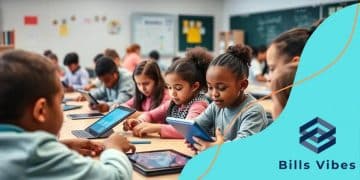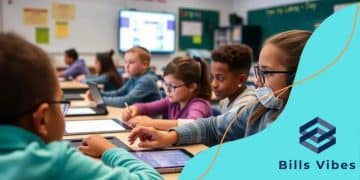Federal policies reshape education: what you need to know

Federal policies reshape education by integrating technology, promoting equity and inclusion, and enhancing social and emotional learning to create more effective educational environments for all students.
Federal policies reshape education in ways that directly affect students and teachers across the country. How do these changes play out in our schools? Let’s dive into the details and see what this means for our future.
Understanding federal education policies
To truly grasp how federal education policies work, we need to understand their purpose and impact. These policies aim to create fair and effective educational opportunities for all students. But how do they shape our schools and learning environments?
Key Components of Federal Education Policies
Federal education policies cover a wide range of areas, including funding, standards, and accountability. They ensure that resources are directed where they are most needed.
- Funding: Federal funds help support low-income schools.
- Accountability: Schools must meet certain standards to receive funding.
- Accessibility: Policies aim to provide resources for students with disabilities.
Understanding how these components interconnect can help us see the broader picture of education in the U.S. For instance, when funding is tied to student performance, schools may innovate to improve outcomes.
The Role of Legislation
Legislation plays a crucial role in shaping these policies. Laws like the Every Student Succeeds Act (ESSA) highlight the shift towards state control while maintaining federal guidelines. This balance allows states to tailor their approaches to fit their unique needs.
Moreover, the impact of these laws goes beyond the classroom. They influence teacher training, curriculum development, and even parental involvement in education. By engaging families, schools can foster a supportive environment that enhances student learning.
Keeping up with changes in federal policies can feel overwhelming, but understanding their implications is essential. By staying informed, educators and parents can better advocate for the needs of students and navigate the educational landscape effectively.
Recent changes in federal education
Recent changes in federal education policies have significantly impacted schools and students across the nation. Understanding these changes is crucial for educators and families alike.
Highlights of Recent Changes
There have been several key updates to federal education policies. These changes aim to address inequities and improve educational outcomes for all students.
- Increased funding: More resources are now directed toward underfunded schools.
- Focus on equity: Policies are designed to support marginalized communities.
- Standardized testing revisions: Changes aim to reduce the emphasis on high-stakes testing.
These changes encourage schools to adopt innovative practices that can lead to better learning experiences. With increased funding, schools can invest in technology and support services that enhance education.
Addressing Equity and Inclusion
The focus on equity means that schools must provide resources and support for all students. This includes tailored programs for students with disabilities and English language learners. By implementing these policies, schools work to create an inclusive environment that fosters success.
Additionally, many districts are reevaluating their curricula to ensure they reflect the diverse backgrounds of their students. This approach not only enhances understanding but also promotes a sense of belonging among all students.
As we’ve seen, recent changes in federal education policies are not just about funding; they also emphasize the importance of inclusivity and support. Engaging with these updates is essential for ensuring that our education system evolves to meet the needs of every student.
The role of funding in educational reform

The role of funding in educational reform is crucial to improving schools and learning outcomes. Effective funding ensures that resources are available to implement changes that benefit students.
Understanding Educational Funding
Educational funding comes from various sources, including federal, state, and local governments. Each level plays a different role in how resources are allocated to schools.
- Federal funding: Typically aims to support low-income schools and improve access to education.
- State funding: Often distributed based on student enrollment and local needs.
- Local funding: Mainly derived from property taxes, which can create disparities between wealthy and less affluent areas.
Without adequate funding, schools struggle to provide the necessary support and resources to help every student succeed. This can lead to larger class sizes, outdated materials, and fewer extracurricular opportunities.
Impact of Funding on Educational Equity
Funding also plays a key role in advancing educational equity. Initiatives designed to close achievement gaps often rely heavily on government investment. As a result, schools with greater needs receive additional funding to support their students.
Programs like Title I and special education funding are vital for providing targeted assistance. They ensure that students from disadvantaged backgrounds have access to quality education and support services.
Moreover, community involvement can enhance funding efforts. Local organizations, businesses, and families can contribute to fundraising initiatives that improve school resources. Engaging the community creates a sense of ownership and shared responsibility in educational outcomes.
In conclusion, the relationship between funding and educational reform is undeniable. A strong financial foundation allows schools to innovate and address the diverse needs of their students, setting the stage for academic success.
Impact of policies on student outcomes
The impact of policies on student outcomes is significant and can shape the educational experiences of young learners. Changes in federal, state, and local policies directly affect how schools operate and how students learn.
The Role of Standards
Education policies often establish standards that schools must follow. These standards help define what students need to know at each grade level. When policies implement strong academic standards, they encourage higher performance.
- Clear expectations: Standards provide a roadmap for both teachers and students.
- Assessment consistency: Regular assessments help gauge student progress.
- Improvement support: Policies can help identify areas needing improvement.
Research shows that clear educational standards lead to better achievement among students. When policies support rigorous expectations, students are more likely to succeed.
Funding and Resources
Funding policies play a crucial role in determining the resources available in schools. Schools that receive adequate funding can provide better facilities, updated technology, and more extracurricular programs.
These enhancements directly influence student well-being and academic success. For example, students in well-funded schools often have access to advanced placement courses and specialized programs.
Additionally, effective policies that allocate funds toward teacher training and development can significantly improve classroom instruction. Teachers with ongoing professional development are better equipped to engage students and manage diverse classrooms.
Moreover, data-driven policies can provide insights into which strategies are working and which need adjustment. This continual cycle of assessment and adjustment allows schools to be responsive to student needs.
Future directions for education policy
The future directions for education policy are evolving rapidly as new challenges and opportunities arise. Policymakers are focusing on various trends that could significantly shape educational practices in the coming years.
Technological Integration
One major direction is the integration of technology in classrooms. With the rise of digital learning tools, schools are looking to enhance students’ learning experiences. This includes using online platforms, educational apps, and virtual classrooms to make education more accessible.
- Blended learning: Combining online and in-person instruction to improve engagement.
- Personalized education: Using data to tailor learning to individual student needs.
- Teacher training: Providing professional development focused on technology use in classrooms.
These innovations can help students learn at their own pace and in ways that work best for them.
Equity and Inclusion
Another important focus is equity and inclusion in education. Policymakers are working to ensure that all students, regardless of their background, have access to quality education. This means addressing disparities in funding and resources among schools in different areas.
Efforts include initiatives to provide support for underserved communities and improve the availability of qualified teachers in high-need areas. By implementing these policies, schools can create a more equitable learning environment for every student.
Additionally, there is a growing emphasis on social and emotional learning (SEL) as part of the curriculum. Recognizing that emotional well-being is essential for academic success, schools are integrating SEL programs to support student development.
As we look to the future, it’s clear that a balance between technology, equity, and social-emotional support will be key in shaping effective education policies. Adapting to these trends will ensure that educational systems can meet the needs of diverse learners.
FAQ – Questions about Federal Policies Reshaping Education
How do federal policies affect my child’s education?
Federal policies provide guidelines for schools, influencing funding and resources that impact your child’s learning experience.
What is the role of technology in future education policies?
Technology integration is key for enhancing learning, helping students with personalized education through better access to resources.
How are equity and inclusion prioritized in education reforms?
Policies aim to ensure that all students regardless of background receive equal opportunities and support to succeed in their education.
What is social and emotional learning, and why is it important?
Social and emotional learning helps students manage emotions and build relationships, crucial for their overall success in school and life.






